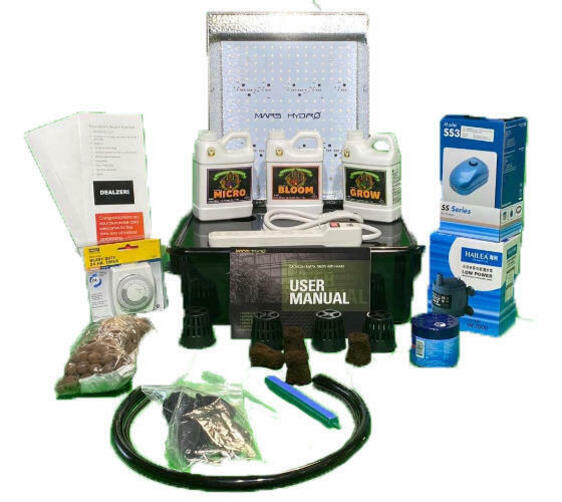
Best Vegetables To Grow Indoors Under Lights
Are you considering what are the best vegetables to grow indoors under lights? We look at a range of tasty vegetables that you can easily grow indoors as part of a healthy diet.

Table of Contents
What Are The Best Vegetables To Grow Indoors Under Lights?
The best vegetables to grow indoors under lights are leafy greens such as lettuce, spinach, watercress, corn salad, kale and sorrel. These plants are able to grow in low- to moderate-light and will be the easiest to grow using artificial lighting.
Other cool-season herbs include cilantro, parsley, and fennel and mint.
Growing leafy greens and cool-season herbs indoors under lights are the best way to get started with indoor growing. These plants are perfect for growing in small spaces as they require little growth area.
Growing Vegetables Indoors With Lights
While leafy greens are the easiest plants to grow indoors under lights, that does not mean that you are restricted to growing these type of vegetables.
In fact, almost any vegetable can be grown indoors under grow lights given the right conditions.
Tomatoes
Botanically, a tomato is a fruit, but is most commonly eaten as a vegetable.
Tomatoes are a great source of potassium, folate, vitamin C and vitamin K offering a range of health benefits.
Tomatoes also contain the antioxidant lycopene, which is linked to reduced risk of heart disease and cancer.
The best varieties of tomato to grow indoors are dwarf tomatoes, but all tomatoes can be grown with the right conditions.
Tomatoes require a lot of light, a good-sized container and plant stake to support the vine as it grows.
Carrots
Carrots are a versatile vegetable which can be a tasty addition to almost any meal.
Carrots are an important source of vitamins and minerals including vitamin A, vitamin K, vitamin C, calcium, iron, potassium and fibre.
The antioxidants within carrots make them good for your eyes, heart and reduces the risk of cancer.
Carrots require deeper soil than many vegetables and need a minimum of 12 hours of light per day.
Radishes
Growing radishes is a great idea for an indoor garden. Ready to harvest 30 to 40 days from germination, radishes are a quick growing vegetable.
The Radish is perfect for growing under indoors as they do not require much light to grow and can be easily grown all year round.
Radishes are rich in nutrients such as potassium which provide a range of health benefits including killing toxins in the liver and stomach.
Chillies
Chillies are one of the best vegetables to grow indoors for beginners. Chillies can be grown in large batches and can be frozen until you want to use them.
Chili peppers are rich in various vitamins and minerals including vitamin C, B6, K1, potassium, copper and vitamin A.
Chillis have unique properties which means they can be used for pain relief, by desensitising the body to the pain receptors over time.
Green Onions / Spring Onion
Green onions or Spring Onions can grow easily indoors without much care requirements.
Green onions grow well in lower lighting conditions than other vegetables, providing crisp stems that add a robust garnish for salads.
Green Onions have antibacterial and antiviral properties, which helps fight cold and flu.
Spring onions also contain fibre which can help with digestion and sulphur compounds which help lower blood sugar levels.
Potatoes
As a staple vegetable in most people’s diet, growing potatoes indoors is a fantastic idea.
Potatoes only require about four inches of soil to grow in, which makes them great if there is limited space.
Potatoes offer a range of health and nutrition benefits, including being a good source of fibre, which can keep you full longer and help you lose weight.
Potatoes are also great for digestive health and are packed with antioxidants.
Spinach
As a leafy vegetable, spinach can easily be grown indoors under a light. Packed with vitamins and minerals, spinach is a great vegetable to include in a healthy diet.
Spinach can be grown indoors if it is provided with abundant light, water and good drainage.
Spinach contains high levels of chlorophyll, beta-carotene, lutein and zeaxanthin. This makes spinach great for healthy eyesight, preventing macular degeneration and cataracts.
Lettuce
Lettuce can be grown indoors, requiring little maintenance, which makes them perfect for beginners.
Lettuce is low in calories, which can assist with weight loss. Lettuce is high in Folate, vitamin C and potassium, which makes it great for improving heart health.
You can grow a lettuce from the unused part of the plant. Simply cut the base from the lettuce and after letting it soak in water, it will begin to sprout roots.
Mushrooms
The perfect accomplishment to almost any meal, growing mushrooms allows you to produce a tasty versatile food.
Considered to offer fantastic health benefits, mushrooms are loaded with many vitamins, minerals, and antioxidants.
Mushrooms grown under ultraviolet light are a great source of vitamin D which is important in bone and immune health.
Mushrooms can be grown all year round indoors. Mushrooms can grow within two or three days, as long as the temperature and soil conditions are suitable.
Ginger
Ginger has been known as containing many medicinal properties. Ginger can help fight the flu and common cold, aid digestion and reduce nausea.
Ginger can easily be grown indoors from a shop-bought ginger. By exposing the ginger to water for a few hours, any growth inhibitor will dissolve, and the bulb can be grown in a grow bag.
Onion
Onion is the basis of many meals. Growing onions indoors and can be grown from seeds or a scrap of onion bought from a store.
Onions grow a bulb under the soil, so require a large enough container. Or you could grow your onion to collect the onion tops, rather than onion bottoms, which require less space to grow.
Onions are packed with nutrients including vitamin C which is important in tissue repair, collagen production, regulating immune health and iron absorption.
Beets
Beets are delicious and add colour to your dinner plate. Beets are rich in folate, which plays a key role in heart health, growth and development.
Beets grow well in 6-8 hours of light per day and PH neutral soil. Bets can grow larger, but harvesting them about the size of a golf ball is when you will get them at their best flavour.
Green Beans
Green beans provide great health benefits as they contain important nutrients such as vitamin C, flavonols, quercetin, and kaemferol.
A great source of fibre, green beans will help keep your digestive system healthy.
Green beans grow well indoors and require a good source of light and a trellis to offer support.
Green beans will require six hours of sunlight per day and moist soil with good drainage.
Kale
Kale is a great vegetable to grow indoors, which can be used in your diet in the same way as spinach.
Kale offers important vitamins for supporting a healthy immune system. Kale contains four times as much vitamin C as spinach and twice the selenium content.
Kale grows well in pots or grow bags, and requires that the soil retains good moisture.
Bell Pepper
Bell peppers offer a great supply of fruit as the more you harvest, the more peppers are produced.
Bell peppers are easy to grow indoors and can be grown from pots, grow bags or plastic bottles.
Bell peppers are loaded with a range of vitamins and minerals. A bell pepper is one of the richest dietary sources of vitamin C and contains other vitamins including B6, K1, potassium, folate, vitamin E and vitamin A.
Arugula
Arugula is a fast-growing vegetable which likes cool temperatures, so is perfect for indoor growing.
Arugula offers many health benefits, including being a source of vitamin K and calcium for healthy bones and good skin.
It can also help with indigestion, prevent risk of cancer and diabetes, improve eye health and reduce high blood pressure.
By harvesting the larger leaves and allowing the smaller ones to continue growing, an arugula plant produces multiple harvests once it reaches maturity.
How To Grow Vegetables Indoors Without Sunlight
If you are thinking about growing vegetables indoors without sunlight, there are plenty of solutions for beginners or experienced farmers.
You will need to consider all of the conditions a plant requires for growth and recreate these conditions using artificial means.
Artificial Lighting
All vegetables are photosynthetic. This means that they convert the energy from light into food. So one important consideration when growing vegetables indoors is providing a replacement for sunlight.
Each vegetable requires different amounts of sunlight to grow efficiently. Lettuce and other leafy greens require less light to grow, while tomatoes need high levels of light.
LED lighting is the best choice for growing most vegetables indoors. LED lights provide more light at a lower cost while not producing too much heat.
Growth Medium
Like outdoor plants, you will need to plant your vegetables in soil or alternative growth medium so that the roots can feed from the nutrients.
Topsoil
Topsoil is rich with all the nutrients a plant will need, created naturally from insect activity and worm castings.
Potting Mix Soil
You can purchase potting mix which is specially created for indoor growing. A potting mix includes soil mixed with perlite for aeration. The aerator helps the plants to breathe and allows for better water drainage.
Compost
Compost offers all the nutrition our plants need for indoor growing. Compost is created from garden waste and household waste after being left to break down naturally.
If you have space to begin a compost pile, you can create free soil for growing your vegetables and fruit from household scraps.
Hydroponics
A hydroponic system allows you to grow vegetables indoors under lights but without the need for soil.
With hydroponics, the liquid flows directly to the roots, containing all the nutrients the plant requires.
In a hydroponic system, the plants need to be placed in a growing medium such as perlite, coir, clay pellets or rock wool to support the plant growth.
Types of Grow Lights Used for Growing Vegetables
The three main types of light for growing vegetables indoors are fluorescent lighting, high-pressure sodium lights or LED lights.
Fluorescent
Fluorescent lighting offers a range of intensities and can be fitted into a regular light socket.
Florescent light bulbs are able to fit in small places. They are available as either thin tubular shaped bulbs or compact fluorescent lighting (CFLs).
CFL lights are one of the least expensive options for beginners who can’t afford the more efficient LED option.
High-Pressure Sodium Lights
If you use high-pressure sodium lights (HPS lights) for growing food, they need to be set further away from the plants. HPS lighting is a higher cost growing light than other options.
LED Lights
LED Lights are the most efficient light for growing vegetables indoors.
LED lighting is popular with indoor growers as they produce little heat, so won’t affect the temperature of the growing environment.
Where to Buy Indoor LED Grow Lights
If you are growing vegetables indoors using artificial grow lights, you can replicate the full spectrum light of the Sun with LED grow lights.
29329 Lumens LED Grow Light

1280W 8X4 LED Grow Light

Hydroponic Growing Systems
Hydroponic growing with artificial lights is an effective way to get started growing vegetables indoors. You can get a head start by investing in ready built sytems.
Hydroponics Systems
A hydroponic system includes everything you need to get started on growing your plants indoors.
4 Plant Hydroponics Kit

5 Gal 8 Bucket Hydroponic System

Hydroponic Grow Boxes
Hydroponic grow boxes are the smart and easy solution for growing food indoors when you are limited by space.
4 Plant LED Grow Box

4 Plant Vertical Grow Box

Grow Tent Systems
If you are ready to grow vegetables indoors, a grow tent provides a ready-made environment to contain light and heat.
5 x 10 Foot Heavy Duty Hydroponics Tent

References:
Interested in growing your own food as a hobby or interest? We have other pages of information about growing food here.
We hope this article offered you enough information about the best vegetables to grow indoors under lights.
Follow the link below to discover other cool hobbies and interests.











One Response